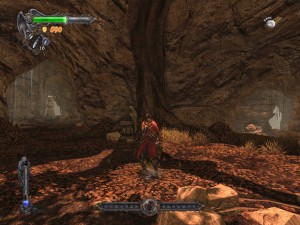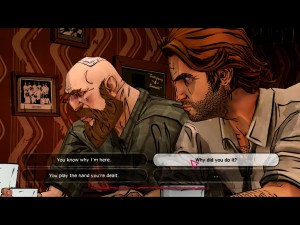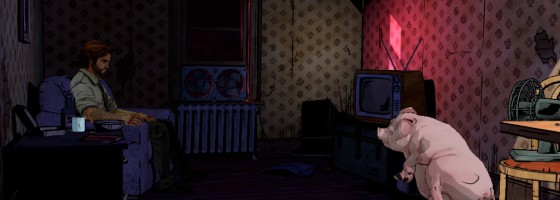A common practice in skill or story based games is to have point of no returns and while their definition should be obvious, their roles when developing a game aren’t. Understanding how to section your game behind point of no returns is an important skill as too many or not enough can ruin the pacing.
One Way:
For this post, we’re going to define point of no returns and their role in game design as the following:
- Point of No Return: An irreversible choice on the player’s part that moves the game forward while locking content away from the player.
When we talk about point of no returns, there are two ways that they can be used and is dependent on what type of game they’re in. For skill based or action titles, points of no returns are used to keep the player moving forward while locking areas that they already visited behind. This can be done via two ways with the first being built into the level design itself.
There are plenty of examples of this such as having the player jump down over a high wall, locked doors, platforms crumbling etc. The other way is essentially making the only parts of the world exist being those that the camera is viewing. This is done in 2D titles such as the old Mega Man games, Mario, etc. This also serves the purpose of not having the game engine be required to render areas that are no longer being viewed by the player.
Modern adventure game design also makes use of point of no returns to section off areas. This serves the purpose of corralling the player into areas with set puzzles and items to use, making it easier to solve the puzzles by limiting their interactions.
With skill based games it’s important to understand the flow of the level and where to set up point of no returns at, especially if you have hidden areas. It’s very annoying missing a hidden area just before a point of no return and forced to have to die or repeat the level over again. Another thing to point out is that when we refer to point of no returns in skill games, we are talking about content that is locked by developer’s intent for the player going forward. If someone wants to restart the level and go another way then that is their prerogative.

Lords of Shadow made frequent use of points of no returns and it made the levels feel lifeless as a result
One other issue is if the game is explicitly designed around forcing the player to replay levels thanks to point of no returns or gated content.
In Castlevania Lords of Shadow, many levels featured one way sections or areas inaccessible without a future upgrade thereby forcing the player to replay every level twice in order to get it all. Good level design should allow the player to see it all if they’re good enough and not locking content behind arbitrary conditions.
Next we have games built around a narrative structure, either RPGs or adventure games and where points of no returns not only impact the gameplay, but the entire story itself.
Chapter by Chapter:
We’ll start with RPGs who in the past make use of point of no returns by combining narrative and gameplay. Many titles will warn the player of an upcoming point of no return and challenge them to prepare for this moment. What happens is that after the boss fight, the story of the game will move forward and lock previous content away from the player, sometimes for the reminder of the game, other times until a later event.
As a designer you need to be aware of where the player will be after a point of no return event as RPGs are built around abstraction and not player skill. If the player is sent to an area without any shops or ways to level up, they may become stuck at the event and unable to progress. If the event will require the player to fight then either allow the player to rewind to before the event or provide the means for them to improve their character in the new area.
With narrative titles, points of no returns are the exact examples of “hard choices” which I talked about in a previous post. As the writer of the story, you need to be aware that every point of no return requires you to alter the structure of the story going forward for each subsequent event. The more you have, the more you will need to provide to the story to serve all the possible timelines that you’ve created.

Not every choice has to (or should be a) hard choice, but if you are promoting player interaction, then some of their choices must carry weight to them
Nothing can piss off a gamer who is following the story more than being told that all their choices matter and then just sweeping them under the rug for the end.
This is the issue that Bioware faced with the Mass Effect trilogy after building a story across all three games while letting the player make key decisions.
Given the number of permutations the developers put in due to their choices, there was no way in hell they could design an ending that would fit all of them in, much less three.
Bioware had two options: Either go the insane route of designing endings to account for every hard choice in the three games or distill the ending down into a few set routes that would fit everything by not referencing them. Of course we all know what they choose to do as the other option would have ballooned the budget to obscene levels.
Telltale realized the difficulty of point of no returns and instead kept them to a minimum. While certain events will alter the story down the line, none of them will change the overall plot that the writers came up with for the game. This is the opposite problem that Bioware had: Where the story became too personalized to wrap up, Telltale’s plots are so general that the player’s choices don’t really matter to them.
It’s important to note when we talk about having to reference a point of no return, that doesn’t mean you need some grand cutscene or plot element in the future. It could be as simple as having a key character shown in a cut-scene or a few more seconds of footage to display, but the point is that the game needs to remember the choice and figure that into how the game plays out. Of course the more weight your choice has to the story, the happier the player will by the fact that they are creating their own personalized story.
Defining Paths:
Point of No Return is an important concept regardless of your game being skill or narrative based. At their most simplest, they section off parts of your game and allow you to know almost definitively the current state of the player based on their actions. But even though they remove options from the player, they will add more work for you to make sure that the player can still progress, either with level design or the plot.
As we’ve seen with Telltale, you don’t need a lot of point of no returns to make an amazing story but if you promise that the player will factor into how things play out then you need to make sure that there is weight to their choices.


